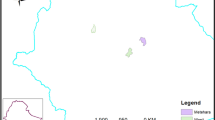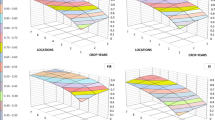Abstract
The selection of sugarcane cultivars adapted to different environments becomes difficult when there is genotype–environment interaction (GEI). The data were analyzed from twenty sugarcane genotypes evaluated in eight locations over two crop cycles to identify megaenvironments (ME), through GEI methods for higher cane yield measured in tons of cane per hectare (TCH) and percentage of sucrose (Pol% cane) using biplot multivariate GEI models. The best genotypes and the environment were determined with better mean yield by the two-table coupling coinertia method. Additive main effects and multiplicative interaction (AMMI) analyses revealed significant GEI with respect to both variables. The AMMI stability value exposed high genotypes stability for Pol% cane, but for TCH just G4, G8, G1, G20 and G17 have stability in all environments. The site-type regression SREG-GGE biplot showed two ME for TCH and one for Pol% cane. Although both yield variables showed mean negative correlation, through coinertia analysis it was possible to determine that G15, G17 and G13 were the best genotypes for both variables in all environments, besides “Los Tamarindos” was the best environment, with both variables correlated positively, and G11, G13, G12 could be considered the better genotypes. This work revealed the necessity of using coinertia as a complementary analysis to AMMI and GGE, which needs to be applied to determine the genotypes and environments that favor multiple yield variables, in order to increase the productivity.






Similar content being viewed by others
References
Akcura, Mevlüt, Seyfi Taner, and Yuksel Kaya. 2011. Evaluation of bread wheat genotypes under irrigated multi-environment conditions using GGE biplot analyses. Agriculture 98(1): 35–40.
Chessel, Daniel, Anne B. Dufour, and J. Jean Thioulouse. 2004. The ade4 package-I-one-table methods. R News 4: 5–10.
Crossa, José, Paul L. Cornelius, and Weikai Yan. 2002. Biplots of linear-bilinear models for studying crossover genotype × environment interaction. Crop Science 42: 619–633.
Culhane, Aedín, Guy Perrière, and Desmond G. Higgins. 2003. Cross-platform comparison and visualisation of gene expression data using co-inertia analysis. BMC Bioinformatics 4(1): 59.
De Mendiburu, Felipe. 2015. Agricolae: Statistical procedures for agricultural research. R package version 1.2-2. http://CRAN.R-project.org/package=agricolae.
Dolédec, Sylvain, and Daniel Chessel. 1994. Co-inertia analysis: An alternative method for studying species-environment relationships. Freshwater Biology 31: 277–294.
Dray, Stéphane, and Anne B. Dufour. 2007. The ade4 package: Implementing the duality diagram for ecologists. Journal of Statistical Software 22(4): 1–20.
Dray, Stéphane, Anne B. Dufour, and Daniel Chessel. 2007. The ade4 package-II: Two-table and K-table methods. R News 7(2): 47–52.
Dray, Stéphane, Daniel Chessel, and Jean Thioulouse. 2003a. Procrustean co-inertia analysis for the linking of ecological tables. Ecoscience 10: 110–119.
Dray, Stéphane, Daniel Chessel, and Jean Thioulouse. 2003b. Co-inertia analysis and the linking of ecological data tables. Ecology 84(11): 3078–3089.
Frutos, Elisa, María P. Galindo, and Victor Leiva. 2014. An interactive biplot implementation in R for modeling genotype-by-environment interaction. Stochastic Environmental Research and Risk Assessment 28(7): 1629–1641.
Ibáñez, Maximiliano, Mario Cavanagh, Natalia Bonamico, and Miguel Di Renzo. 2006. Análisis gráfico mediante biplot del comportamiento de híbridos de maíz. Revista de Investigaciones Agropecuarias 5(3): 83–93.
Jalata, Zerihun. 2011. GGE-biplot analysis of multi-environment yield trials of barley (Hordeium vulgare. L.) genotypes in Southeastern Ethiopia Highlands. International Journal of Plant Breeding and Genetics 5(1): 59–75.
Kempton, Robert. 1984. The use of biplots in interpreting variety by environment interactions. The Journal of Agricultural Science 103: 123–135.
Mortazavian, Seyed, H. Nikkhah, F. Hassani, M. Sharif-al-Hosseini, M. Taheri, and M. Mahlooji. 2014. GGE biplot and AMMI analysis of yield performance of barley genotypes across different environments in Iran. Journal of Agricultural Science and Technology 16: 609–622.
Ramburan, Sanesh, and Marvellous Zhou. 2011. Investigating sugarcane genotype × environment interactions under rainfed conditions in South Africa using variance components and biplot analysis. Proceedings of the South African Sugar Technology Association 84: 245–362.
Rao, Srinivasa, Sanjana Reddy, Abhishek Rathore, Belum V. Reddy, and Sanjeev Panwar. 2011. Application GGE biplot and AMMI model to evaluate sweet sorghum (Sorghum bicolor) hybrids for genotype × environment interaction and seasonal adaptation. Indian Journal of Agricultural Science 81(5): 438–444.
Rea, Ramón, and Orlando De Sousa-Vieira. 2002. Genotype × environment interaction in sugarcane yield trials in the central-western region of Venezuela. Interciencia 27(11): 620–624.
Rea, Ramón, Orlando De Sousa-Vieira, Miguel Ramón, Gleenys Alejos, Alida Díaz, and Rosaura Briceño. 2011. AMMI analysis and its application to sugarcane regional trials in Venezuela. Sugar Tech 13(2): 108–113.
Rodríguez, Reynaldo, Yaquelin Puchades, Norge Bernal, Héctor J. Suárez, and Héctor García. 2012. Métodos estadísticos en el estudio de la interacción genotipo–ambiente en caña de azúcar. Ciencia en su PC 1: 47–60.
Roostaei, Mozaffar, Reza Mohammadi, and Ahmed Amri. 2014. Rank correlation among different statistical models in ranking of winter wheat genotypes. The Crop Journal 2: 154–163.
Silveira, Luís, Volmir Kist, Thiago O. Paula, Márcio H. Barbosa, Luiz A. Peternelli, and Edelclaiton Daros. 2013. AMMI analysis to evaluate the adaptability and phenotypic stability of sugarcane. Scientia Agricola 70(1): 27–32.
Yan, Weikai, and Nicholas A. Tinker. 2006. Biplot analysis of multi-environment trial data: Principles and applications. Canadian Journal of Plant Science 86: 623–664.
Yan, Weikai, Manjit S. Kang, Baoluo Ma, Sheila Woods, and Paul L. Cornelius. 2007. GGE biplot vs. AMMI analysis of genotype-by-environment data. Crop Science 47: 641–653.
Yan, Weikai. 2002. Singular value partition for biplot analysis of multi-environment trial data. Agronomy Journal 94: 990–996.
Yan, Weikai. 2011. GGE Biplot vs. AMMI graphs for genotype-by-environment data analysis. Journal of the Indian Society of Agricultural Statistics 65(5): 181–193.
Acknowledgments
The authors would like to thank the Venezuela’s National Institute for Agricultural Research (INIA) and the Venezuelan Endowment for Science, Technology and Innovation (FONACIT) for the financing of regional trials.
Author information
Authors and Affiliations
Corresponding author
Rights and permissions
About this article
Cite this article
Rea, R., De Sousa-Vieira, O., Díaz, A. et al. Genotype–Environment Interaction, Megaenvironments and Two-Table Coupling Methods for Sugarcane Yield Studies in Venezuela. Sugar Tech 18, 354–364 (2016). https://doi.org/10.1007/s12355-015-0407-9
Received:
Accepted:
Published:
Issue Date:
DOI: https://doi.org/10.1007/s12355-015-0407-9




